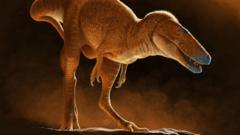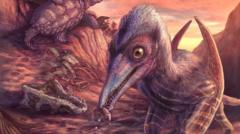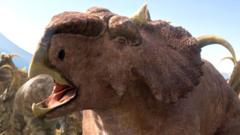The discovery of a new dinosaur species challenges previous understandings of tyrannosaur evolution, revealing vital features that contributed to the family's dominance.
**New Tyrannosaur Ancestor Discovered, Altering Evolutionary Map of Dinosaurs**

**New Tyrannosaur Ancestor Discovered, Altering Evolutionary Map of Dinosaurs**
Researchers unveil Khankhuuluu mongoliensis, a crucial ancestor rewriting the tyrannosaur lineage.
The recent finding of a new dinosaur species in a Mongolian museum collection has significant implications for the evolutionary history of tyrannosaurs. Named Khankhuuluu mongoliensis, which translates to Dragon Prince of Mongolia, this new species is identified as the closest known ancestor of all tyrannosaurs, including the famous T. rex. The researchers, whose work is published in the journal Nature, studied two skeletons aged approximately 86 million years, indicating this dinosaur represents a crucial link in understanding the evolution of powerful predators that roamed North America and Asia.
Lead researcher PhD student Jared Voris, alongside palaeontologist Prof. Darla Zelenitsky from the University of Calgary, highlighted that this discovery illustrates a pivotal evolution from earlier, smaller tyrannosauroids to the formidable giants known to dominate the dinosaur era. At about 750 kg, Khankhuuluu was considerably smaller than the massive T. rex, which could weigh up to eight times more. The significance of this find lies in its ability to revise and enhance our comprehension of the tyrannosaur family tree.
As an early predator, Khankhuuluu possessed characteristics that foretell the evolution of the infamous powerful jaws found in later tyrannosaurs. Features in its skull provide insight into how these dinosaurs developed the ability to hunt larger prey and eventually dominate their ecosystems. Originally thought to belong to a known species called Alectrosaurus, the renewed analysis emphasizes how paleontologists can often misidentify fossils without the latest techniques.
The connection between North America and Asia via prehistoric land bridges allowed for the migration and diversification of these dinosaurs across the continents. This interaction fostered evolutionary developments, resulting in different branches of tyrannosaurs over millennia. Prof. Zelenitsky expressed that Khankhuuluu is not just a transition fossil; it shows the journey from being diminutive predators to the iconic apex carnivores that would follow. This exciting revelation reiterates that, long before they became royalty, tyrannosaurs were once the princely hunters of their time.
Lead researcher PhD student Jared Voris, alongside palaeontologist Prof. Darla Zelenitsky from the University of Calgary, highlighted that this discovery illustrates a pivotal evolution from earlier, smaller tyrannosauroids to the formidable giants known to dominate the dinosaur era. At about 750 kg, Khankhuuluu was considerably smaller than the massive T. rex, which could weigh up to eight times more. The significance of this find lies in its ability to revise and enhance our comprehension of the tyrannosaur family tree.
As an early predator, Khankhuuluu possessed characteristics that foretell the evolution of the infamous powerful jaws found in later tyrannosaurs. Features in its skull provide insight into how these dinosaurs developed the ability to hunt larger prey and eventually dominate their ecosystems. Originally thought to belong to a known species called Alectrosaurus, the renewed analysis emphasizes how paleontologists can often misidentify fossils without the latest techniques.
The connection between North America and Asia via prehistoric land bridges allowed for the migration and diversification of these dinosaurs across the continents. This interaction fostered evolutionary developments, resulting in different branches of tyrannosaurs over millennia. Prof. Zelenitsky expressed that Khankhuuluu is not just a transition fossil; it shows the journey from being diminutive predators to the iconic apex carnivores that would follow. This exciting revelation reiterates that, long before they became royalty, tyrannosaurs were once the princely hunters of their time.










